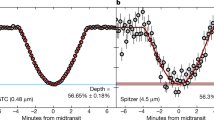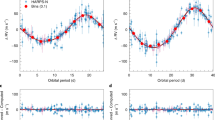Abstract
The class of exotic Jupiter-mass planets that orbit very close to their parent stars were not explicitly expected before their discovery1. The recently discovered2 transiting planet WASP-12b has a mass M = 1.4 ± 0.1 Jupiter masses (MJ), a mean orbital distance of only 3.1 stellar radii (meaning it is subject to intense tidal forces), and a period of 1.1 days. Its radius 1.79 ± 0.09RJ is unexpectedly large and its orbital eccentricity 0.049 ± 0.015 is even more surprising because such close orbits are usually quickly circularized. Here we report an analysis of its properties, which reveals that the planet is losing mass to its host star at a rate of about 10-7MJ per year. The planet’s surface is distorted by the star’s gravity and the light curve produced by its prolate shape will differ by about ten per cent from that of a spherical planet. We conclude that dissipation of the star’s tidal perturbation in the planet’s convective envelope provides the energy source for its large volume. We predict up to 10 mJy CO band-head (2.292 μm) emission from a tenuous disk around the host star, made up of tidally stripped planetary gas. It may also contain a detectable resonant super-Earth, as a hypothetical perturber that continually stirs up WASP-12b’s eccentricity.
This is a preview of subscription content, access via your institution
Access options
Subscribe to this journal
Receive 51 print issues and online access
$199.00 per year
only $3.90 per issue
Buy this article
- Purchase on Springer Link
- Instant access to full article PDF
Prices may be subject to local taxes which are calculated during checkout

Similar content being viewed by others
References
Mayor, M. & Queloz, D. A. Jupiter-mass companion to a solar-type star. Astrophys. J. 378, 355–359 (1995)
Hebb, L. et al. WASP-12 b: the hottest transiting extra solar-planet yet discovered. Astrophys. J. 693, 1920–1928 (2009)
Bodenheimer, P., Laughlin, G. & Lin, D. N. C. On the radii of extrasolar giant planets. Astrophys. J. 592, 555–563 (2003)
Fortney, J. J., Marley, M. S. & Barnes, J. W. Planetary radii across five orders of magnitude in mass and stellar insolation: application to transits. Astrophys. J. 659, 1661–1672 (2007)
Bodenheimer, P., Lin, D. N. C. & Mardling, R. A. On the tidal inflation of short-period extrasolar planets. Astrophys. J. 548, 466–472 (2001)
Guillot, T., Burrow, A., Hubbard, W. B., Lunine, J. I. & Saumon, D. Giant planets at small orbital distances. Astrophys. J. 459, L35–L38 (1996)
Dobbs-Dixon, I. & Lin, D. N. C. Atmospheric dynamics of short-period extrasolar gas giant planets. I. Dependence of nightside temperature on opacity. Astrophys. J. 673, 513–525 (2008)
Garcia Munoz, A. Physical and chemical aeronomy of HD 209458b. Planet. Space Sci. 55, 1426–1455 (2007)
Hubbard, W. B., Hattori, M. F., Burrows, A., Hubeny, I. & Sudarksy, D. Effects of mass loss for highly-irradiated giant planets. Icarus 187, 358–364 (2007)
Dobbs-Dixon, I., Lin, D. N. C. & Mardling, R. A. Spin-orbit evolution of short-period planets. Astrophys. J. 610, 464–476 (2004)
Goldreich, P. & Soter, S. Q in the Solar System. Icarus 5, 375–389 (1966)
Ogilvie, G. I. & Lin, D. N. C. Tidal dissipation in rotating giant planets. Astrophys. J. 610, 477–509 (2004)
Ogilvie, G. I. & Lin, D. N. C. Tidal dissipation in rotating solar-type stars. Astrophys. J. 661, 1180–1191 (2007)
Yoder, C. F. & Peale, S. J. The tide of Io. Icarus 47, 1–35 (1981)
Knutson, H. et al. A map of the day-night contrast of the extrasolar planet HD 189733b. Nature 447, 183–186 (2007)
Lin, D. N. C. & Papaloizou, J. C. B. in Protostars and Planets III (eds Black, D. & Mathews, M.) 749–835 (University of Arizona Press, 1993)
Adams, F. C., Shu, F. H. & Lada, C. J. The disks of T Tauri stars with flat infrared spectra. Astrophys. J. 326, 865–883 (1988)
Hartmann, L., Calvet, N., Gullbring, E. & D’Alessio, P. Accretion and the evolution of T Tauri disks. Astrophys. J. 495, 385–400 (1998)
Najita, J., Carr, J. S., Glassgold, A. E., Shu, F. H. & Tokunaga, A. T. Kinematic diagnostics of disks around young stars: CO overtone emission from WL 16 and 1548C27. Astrophys. J. 462, 919–936 (1996)
Vauclair, S. Metallic fingers and metallicity excess in exoplanets’ host stars: the accretion hypothesis revisited. Astrophys. J. 605, 874–879 (2004)
Sasselov, D. D. The new transiting planet OGLE-TR-56b: orbit and atmosphere. Astrophys. J. 596, 1327–1331 (2003)
Hellier, C. et al. An orbital period of 0.94 days for the hot-Jupiter planet WASP-18b. Nature 460, 1098–1100 (2009)
Meibom, S., Mathieu, R. D. & Stassun, K. G. An observational study of tidal synchronization in solar-type binary stars in the open clusters M35 and M34. Astrophys. J. 653, 621–635 (2006)
Peale, S., Cassen, P. & Reynolds, R. T. Melting Io by tidal dissipation. Science 203, 892–894 (1979)
Lin, D. N. C. & Papaloizou, J. On the structure of circumbinary accretion disks and the tidal evolution of commensurable satellites. Mon. Not. R. Astron. Soc. 188, 191–201 (1979)
Tanaka, H., Takeuchi, T. & Ward, W. R. Three-dimensional interaction between a planet and an isothermal gaseous disk. I. Corotation and Lindblad torques and planet migration. Astrophys. J. 565, 1257–1274 (2002)
Acknowledgements
This work is supported by the Kavli Foundation, which enabled the initiation and development of this work at KIAA-PKU. It is also supported by NASA, JPL and the NSF.
Author Contributions S.-l.L. and D.N.C.L. constructed arguments for mass loss and tidal heating of WASP-12b, and also composed the draft of the paper. N.M. brought WASP-12b’s large radius to the attention of the team and designed the illustration. J.J.F. contributed information on the planet’s opacity and improved the presentation of the manuscript.
Author information
Authors and Affiliations
Corresponding author
Ethics declarations
Competing interests
The authors declare no competing financial interests.
Supplementary information
Supplementary Information
This file contains supplementary Methods and Supplementary References. (PDF 81 kb)
PowerPoint slides
Rights and permissions
About this article
Cite this article
Li, Sl., Miller, N., Lin, D. et al. WASP-12b as a prolate, inflated and disrupting planet from tidal dissipation. Nature 463, 1054–1056 (2010). https://doi.org/10.1038/nature08715
Received:
Accepted:
Issue Date:
DOI: https://doi.org/10.1038/nature08715
This article is cited by
-
High-resolution detection of neutral oxygen and non-LTE effects in the atmosphere of KELT-9b
Nature Astronomy (2021)
-
Tidal decay and stable Roche-lobe overflow of short-period gaseous exoplanets
Celestial Mechanics and Dynamical Astronomy (2016)
-
Searching for a gas cloud surrounding the WASP-18 planetary system
Astrophysics and Space Science (2014)
Comments
By submitting a comment you agree to abide by our Terms and Community Guidelines. If you find something abusive or that does not comply with our terms or guidelines please flag it as inappropriate.



